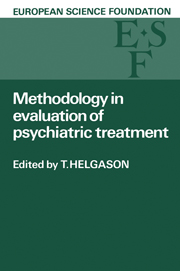 Methodology in Evaluation of Psychiatric Treatment
Methodology in Evaluation of Psychiatric Treatment Book contents
- Frontmatter
- Contents
- Participants
- Foreword
- Preface
- INTRODUCTION
- I METHODS OF CLASSIFICATION
- II EVALUATION CRITERIA
- III RATING METHODS IN EVALUATION OF TREATMENT
- IV OTHER QUANTITATIVE METHODS OFEVALUATION OF TREATMENT
- Psychophysiological Criteria
- Biological Quantitative Methods in the Evaluation of Psychiatric Treatment: SomeBiochemical Criteria
- V ETHICALAND PRACTICAL PROBLEMS
- Index
Psychophysiological Criteria
from IV - OTHER QUANTITATIVE METHODS OFEVALUATION OF TREATMENT
- Frontmatter
- Contents
- Participants
- Foreword
- Preface
- INTRODUCTION
- I METHODS OF CLASSIFICATION
- II EVALUATION CRITERIA
- III RATING METHODS IN EVALUATION OF TREATMENT
- IV OTHER QUANTITATIVE METHODS OFEVALUATION OF TREATMENT
- Psychophysiological Criteria
- Biological Quantitative Methods in the Evaluation of Psychiatric Treatment: SomeBiochemical Criteria
- V ETHICALAND PRACTICAL PROBLEMS
- Index
Summary
Introduction
Darrow (1964) defined psychophysiology as “the science which concerns those physiological activities which underlie or relate to psychic functions”. This wide definition could be construed to refer to a very comprehensive range of central nervous system functions but in practice a particular experimental approach using certain physiological measures is accepted as that of psychophysiology. The position of psychophysiology has been an uneasy one, spanning the area between human physiology and psychology and yet developing concepts and principles which are peculiar to itself. Nevertheless, certain fundamental principles have to be upheld. Firstly, the functions that are recorded are basically physiological and, therefore, must be measured under strictly physiological conditions. For example, cardiovascular variables must be recorded under carefully controlled conditions. Secondly, the measures have to be shown to have some psychological validity. The heart pumps blood round the body and its rate is primarily governed by this need. In times of stress an increase in heart-rate may occur but this may reflect increased bodily activity rather than psychological arousal. There is no easy solution to this problem of apportioning bodily changes into the physiological and psychophysiological. However, two measures have come over the years to be regarded as particularly useful because their physiological element is minor. These are skin conductance (sweat-gland activity) and the electroencephalogram (EEG) analysed mathematically.
Psychophysiological techniques have been used mainly to aid in the diagnosis of psychiatric patients, to elucidate central mechanisms of mental illness and to monitor response to treatment. Inthis presentation, the last application will be outlined with particular emphasis on the practical value of these complex techniques. Firstly, the relevant techniques will be briefly outlined.
Psychophysiological techniques
Peripheral autonomic
The most commonly used measure is the palmar skin conductance which provides an indirect measure of non-thermo-regulatory sweating on the palms of the hands. The responses to stimuli, an increase in conductance, are termed galvanic skin responses (GSR) or electrodermal responses. Useful information can be obtained from the changes in skin conductance level, the responses, and ‘spontaneous’ fluctuations in level. Skin potential is a related but more complex measure.
Several cardiovascular measures are in use of which heart-rate is the most popular. This can be recorded from the ECG or from a pulse detector. Variations in beat-to-beat interval rate are of interest. Blood flow through the forearm (muscle blood flow) or the finger (skin blood flow) can be measured plethysmographically.
- Type
- Chapter
- Information
- Methodology in Evaluation of Psychiatric TreatmentProceedings of a Workshop Held in Vienna 10–13 June 1981, pp. 221 - 230Publisher: Cambridge University PressPrint publication year: 1983


